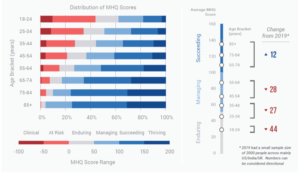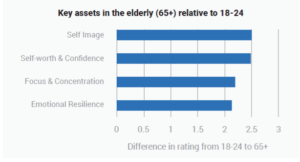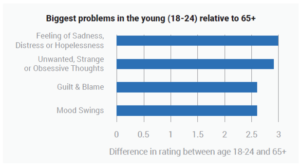Mental wellbeing is worse with each successive generation. What is behind this and what does say about the future?
In previous posts we’ve talked about the relationship between mental wellbeing and age (see related posts Young Adults Struggle With Mental Wellbeing and Mental Health Issues Rising in Young Adults), highlighting evidence that 75% of adults with a mental health disorder had experienced its first onset by the age of 24 [1-2]. Combined with other findings that suggest mental health challenges are affecting younger people with increasing prevalence [3], and that mental health struggles in early life can lead to poorer physical health in middle-age and advanced aging [4-5], this suggests a growing societal risk.
Systematic decline in mental wellbeing with decreasing age
In our first annual 2020 Mental State of the World Report, released last week, we analysed data from ~49,000 internet enabled respondents living in 8 English speaking countries, and found a profound and systematic decrease in mental wellbeing across each successively younger generation. Using the MHQ, an online, anonymous assessment tool which provides scores along 47 indicators of mental wellbeing using a unique life impact rating scale, we found the average MHQ score for adults aged 65 and over was 115, while 18-24 years old had an average score of 29, a decline of 29% down the MHQ scale (Figure 1; scale ranges from -100 to + 200). Furthermore, the proportion of respondents in the Clinical and At risk categories was only 6% among the 65+, but 44% in the 18-24 group. Conversely 70% of those aged 65+ were in the categories Succeeding or Thriving compared to only 17% of 18-24 year olds.

Figure 1: Distribution of MHQ Scores across different age groups
What’s more, we see this generational decline in mental wellbeing across respondents living in all the 8 countries that we looked at, suggesting this to be a global phenomenon of the English speaking Internet world.
Decline exacerbated by the Covid-19 pandemic
Although formal data collection for the Mental Health Million project began in April 2020, just before the Covid-19 pandemic took hold, we also have a smaller dataset for 2019 (~2000 respondents) which show that the difference across generations was present even before the pandemic but has been substantially exacerbated by the Covid-19 pandemic. Mental wellbeing decreased most dramatically in 2020 (relative to 2019) for those aged 18-24, with a decrease of 44 MHQ points (a 15% shift along the MHQ scale) while those in older age brackets saw smaller changes in their average scores (ranged from -28 to +12 MHQ points). This finding aligns with other reports that the consequences of the pandemic are having a disproportionate impact on the young [6] even though this group is at least risk of severe illness or death from Covid-19.
Beyond aggregate scores
Age groups vary across different elements of their mental wellbeing. The differences between young and old were greatest for the dimensions of Social Self – how people relate to and see themselves with respect to others – and Mood & Outlook. Digging deeper, the specific elements of mental wellbeing that were substantially better in older adults were Self-image, Self-worth and Confidence, Focus and Concentration and Emotional resilience (Figure 2). Conversely young adults struggled substantially more with Feelings of sadness, distress or hopelessness, Unwanted, strange or obsessive thoughts, Mood swings and Guilt and blame, compared to those aged 65+.


Figure 2: Key differences between 18-24 year olds and 65+
What could account for these differences?
What could account for this considerable difference across generations? Is it that we become better equipped to cope with life as we age? Or is it that the changing forces of the world have had a disproportionate impact on younger age groups? The fact that reductions were seen across the board from Social Self to Core Cognition raises the possibility that young adults may not as easily calibrate their expectations or self-perceptions relative to the wider society, while the higher self-confidence and emotional resilience with age may suggest a natural maturing and perspective as we age, something also highlighted by others [7]. The outcomes in younger adults may also be influenced by a shadow effect, where major issues such as Feelings of sadness, distress or hopelessness cast a shadow on how the individual views other aspects of their functioning.
On the other hand, challenges with Focus and concentration, Self-worth and confidence and Feelings of sadness, distress or hopelessness suggest a different explanation. We know that 18-24 year olds are the first generation to grow up immersed fully in an internet-connected world and the major societal shifts brought about by this change may not be fully appreciated. For instance, relationships that were once based on physical proximity and repeated contact are now increasingly replaced with virtual relationships. Young adults now report fewer strong friendships. How much does this influence the decline in how people view themselves and the ability to trust and resolve conflict with others?
Tracking mental wellbeing as it evolves over time.
What’s clear is that the magnitude of differences that we see in our 2020 data are warning signs of worrying forces at play. What are the consequences of a society that lacks focus and concentration and where unwanted, strange and obsessive thoughts take over? What if these challenges persist as they transition to middle age and beyond? It is imperative that we invest fully as a society to understand the drivers of this considerable generation shift in mental wellbeing and address them at their root causes. As the Mental Health Million project continues into 2021 and beyond, we will be able to look longitudinally to see how this year’s 18-24 year olds fare in their next decade, providing increasingly deeper insight that can help drive mitigating strategies and track their success.
Find out more by reading our 2020 report which can be accessed here.
References
[1] Kessler, R.C., Amminger, G.P., Aguilar-Gaxiola, S., Alonso, J., Lee, S., and Ustün, T.B. (2007). Age of onset of mental disorders: a review of recent literature. Curr Opin Psychiatry 20(4), 359-364. doi: 10.1097/YCO.0b013e32816ebc8c.
[2] Kessler, R.C., Berglund, P., Demler, O., Jin, R., Merikangas, K.R., and Walters, E.E. (2005). Lifetime prevalence and age-of-onset distributions of DSM-IV disorders in the National Comorbidity Survey Replication. Arch Gen Psychiatry 62(6), 593-602. doi: 10.1001/archpsyc.62.6.593.
[3] Twenge, J.M., Cooper, A.B., Joiner, T.E., Duffy, M.E., and Binau, S.G. (2019). Age, period, and cohort trends in mood disorder indicators and suicide-related outcomes in a nationally representative dataset, 2005-2017. J Abnorm Psychol 128(3), 185-199. doi: 10.1037/abn0000410.
[4] Richmond-Rakerd, L.S., D’Souza, S., Milne, B.J., Caspi, A., and Moffitt, T.E. (2021). Longitudinal Associations of Mental Disorders With Physical Diseases and Mortality Among 2.3 Million New Zealand Citizens. JAMA Netw Open 4(1), e2033448. doi: 10.1001/jamanetworkopen.2020.33448.
[5] Wertz, J., Caspi, A., Ambler, A., Broadbent, J., Hancox, R.J., Harrington, H., et al. (2021). Association of History of Psychopathology With Accelerated Aging at Midlife. JAMA Psychiatry. doi: 10.1001/jamapsychiatry.2020.4626.
[6] Varma, P., Junge, M., Meaklim, H., and Jackson, M.L. (2020). Younger people are more vulnerable to stress, anxiety and depression during COVID-19 pandemic: A global cross-sectional survey. Prog Neuropsychopharmacol Biol Psychiatry 109, 110236. doi: 10.1016/j.pnpbp.2020.110236.
[7] Reed, A.E., and Carstensen, L.L. (2012). The theory behind the age-related positivity effect. Frontiers in psychology 3, 339-339. doi: 10.3389/fpsyg.2012.00339.



















MAYBE it’s because of the now virtually inescapable radiofrequency radiation emitted by mobile phones and WiFi:
https://www.sciencedirect.com/science/article/pii/S0891061815000599
Sue… no